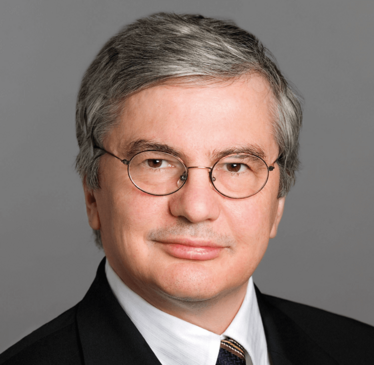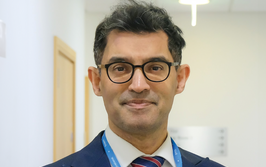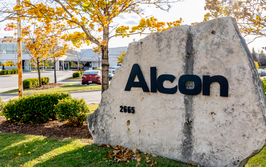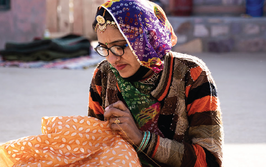VEGF Veteran
Sitting Down With... Napoleone Ferrara, Distinguished Professor of Pathology and Distinguished Adjunct Professor of Ophthalmology, UC San Diego School of Medicine, California, USA
Take us back to the beginning...
In 1983, after finishing medical school in Catania, I came to the US. At that time in Italy, going to medical school was a good route if you were interested in research – as PhD programs were not well established yet. Fortunately, I was offered a great opportunity to do a fellowship at the University of California in San Francisco (UCSF) – and that’s where the VEGF story began. In those early years at UCSF working on neuroendocrinology, I came across an intriguing finding: pituitary cells seemed to be stimulating blood vessel growth. I tested pituitary cell supernatant on endothelial cells, and to my surprise there was strong angiogenic activity. I speculated that it could lead to something interesting, so I began to follow it up.

Can you give a ‘potted’ history of your VEGF work?
I started trying to purify the protein that was behind the activity. However, the technology in that period was very different from today. Now, we have a completed genome, but at that time very few genes were known. If you wanted to advance the field, there was a long way to go. You needed to isolate the protein and determine its amino-terminal amino acid sequence, a task that could take 10 years. But I was young and irresponsible, so I decided to take on the challenge. Many people told me I was crazy for spending many years working on something that could already be well-known or unimportant. But I decided to pursue it anyway.
A key event in the history was joining Genentech in 1988. I was extremely fortunate that the company allowed some time for discretionary research. I used this time to pursue my favorite project. They had incredible technology and great people, and we made very rapid progress. Within six months, we were able to determine the amino acid sequence of the protein – which was very exciting because it was a novel sequence with no match in any database. Based on the amino acid sequence we were able to clone the gene, which really opened up further research opportunities. Knockout studies revealed how important VEGF activity was for angiogenesis; when one copy of the gene was inactivated, embryos couldn’t develop any blood vessels and died. We’d also developed a monoclonal antibody against VEGF – the precursor to bevacizumab – and found it had a profound effect in limiting tumor growth.
And the eye?
Around the same time, there was a hypothesis that angiogenesis might also be important in eye diseases such as diabetic retinopathy. So we started looking into that too. Along with collaborators in Boston who provided clinical samples and animal models, we were able to show a striking correlation between the level of VEGF in the vitreous and retinal angiogenesis. Using the monoclonal antibody and other VEGF blocking agents developed in our laboratory, we demonstrated that blocking VEGF had a profound effect on blood vessel growth and retinopathy in animal models.
It must be rewarding to see bevacizumab having such an impact...
It’s done pretty well! It has 10 FDA approvals and has become a standard therapy in several cancers. But I think that anti VEGF therapy, which today includes multiple molecules, has had the biggest impact in ophthalmology. I don’t think I’m biased in saying that VEGF has completely transformed and revolutionized the field. It is incredibly gratifying to see and I am extremely happy that the work I initiated so long ago has reached this point.
How did you find the transition back into academia?
I’ve spent most of my career at Genentech, and have been back in academia five years. They are different worlds. Academia can expand your ability to collaborate, but at Genentech, there was a very rigorous kind of work that would lead you somewhere faster. I am very pleased to have the opportunity to see these two different perspectives!
What are you focusing on right now?
We, like many people, are trying to go beyond VEGF in cancers and eye diseases. So far, it has been difficult. But there are some interesting things on the horizon, such as inflammatory angiogenesis. We’ve also been working on the eye and cancer and have obtained intriguing preliminary data suggesting the existence of new molecules to target, in addition to VEGF. At this point, the data is too early to share, but we are hopeful that the work will pan out.
The future of anti-angiogenesis?
Although it has been unfortunate that most clinical trials investigating combination therapies with anti-VEGF have proved unsuccessful, I see combined therapies being important. Data suggests that combining anti-angiogenesis with immunotherapy could provide significant benefits in cancer. In the eye, the story is a little more complex. There was a lot of hope that combining anti-VEGF agents with drugs targeting the complement pathway could be beneficial in treating macular degeneration. Unfortunately, this has not yet worked; it was disappointing that lampalizumab failed in phase III clinical trials because this drug could have opened up the possibility of targeting another critical component of the disease, geographic atrophy. However, lampalizumab was only an initial attempt; further research may succeed.
What inspires you?
I started with a real curiosity to discover what was happening in a biological process – angiogenesis. Curiosity has become the common denominator in my career – it’s what makes being a scientist fun. I am no longer a young investigator but I am still just as intrigued, which inspires me to go work.
Napoleone Ferrara was involved in the isolation and cloning of VEGF and demonstrated its role in angiogenesis. His work helped lead to the development and initial approval of bevacizumab for use in colorectal cancer. He was also involved in the clinical development of ranibizumab as a potential therapy for wet AMD. Today, his lab investigates non-VEGF-related angiogenesis mechanisms which may lead to therapies effective in anti-VEGF non-responders, in particular the role of the microenvironment and of factors produced by immune cells and fibroblasts in resistance to VEGF inhibitors.













